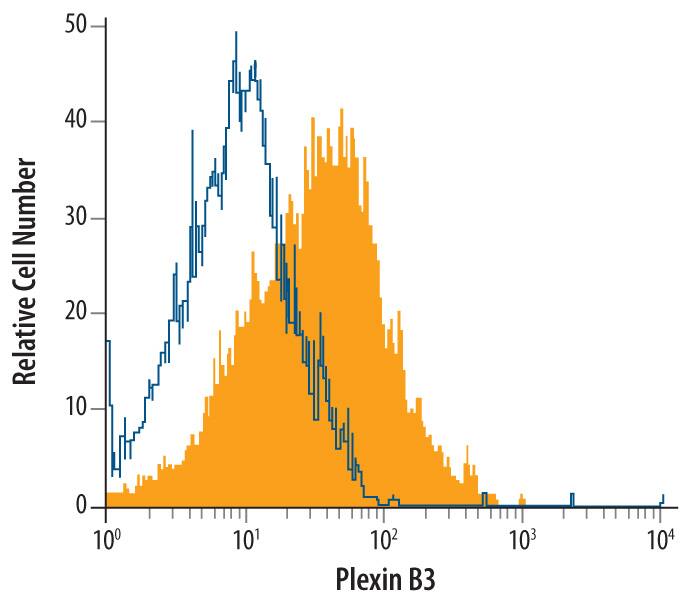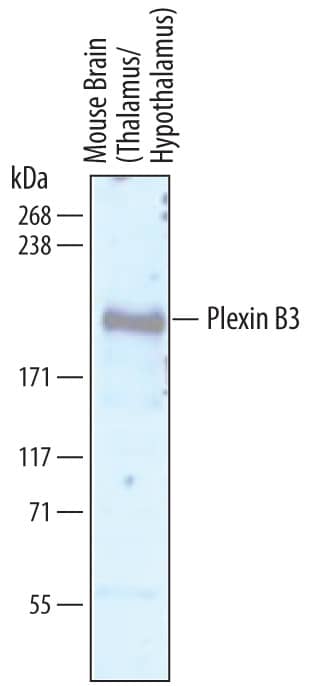Mouse/Rat Plexin B3 Antibody
R&D Systems, part of Bio-Techne | Catalog # AF6879

Key Product Details
Species Reactivity
Validated:
Cited:
Applications
Validated:
Cited:
Label
Antibody Source
Product Specifications
Immunogen
His25-Gln1235
Accession # Q9QY40
Specificity
Clonality
Host
Isotype
Scientific Data Images for Mouse/Rat Plexin B3 Antibody
Detection of Mouse Plexin B3 by Western Blot.
Western blot shows lysates of mouse brain (thalamus/hypothalamus) tissue. PVDF membrane was probed with 1 µg/mL of Sheep Anti-Mouse/Rat Plexin B3 Antigen Affinity-purified Polyclonal Antibody (Catalog # AF6879) followed by HRP-conjugated Anti-Sheep IgG Secondary Antibody (Catalog # HAF016). A specific band was detected for Plexin B3 at approximately 180-190 kDa (as indicated). This experiment was conducted under reducing conditions and using Immunoblot Buffer Group 1.Detection of Plexin B3 in Neuro‑2A Mouse Cell Line by Flow Cytometry.
Neuro-2A mouse neuroblastoma cell line was stained with Sheep Anti-Mouse/Rat Plexin B3 Antigen Affinity-purified Polyclonal Antibody (Catalog # AF6879, filled histogram) or isotype control antibody (Catalog # 5-001-A, open histogram), followed by Allophycocyanin-conjugated Anti-Sheep IgG Secondary Antibody (Catalog # F0127).Detection of Plexin B3 in C6 Rat Cell Line by Flow Cytometry.
C6 rat glioma cell line was stained with Sheep Anti-Mouse/Rat Plexin B3 Antigen Affinity-purified Polyclonal Antibody (Catalog # AF6879, filled histogram) or isotype control antibody (Catalog # 5-001-A, open histogram), followed by Allophycocyanin-conjugated Anti-Sheep IgG Secondary Antibody (Catalog # F0127).Applications for Mouse/Rat Plexin B3 Antibody
CyTOF-ready
Flow Cytometry
Sample: Neuro‑2A mouse neuroblastoma cell line and C6 rat glioma cell line
Immunohistochemistry
Sample: Perfusion fixed frozen sections of mouse brain
Western Blot
Sample: Mouse brain (thalamus/hypothalamus) tissue
Formulation, Preparation, and Storage
Purification
Reconstitution
Formulation
Shipping
Stability & Storage
- 12 months from date of receipt, -20 to -70 °C as supplied.
- 1 month, 2 to 8 °C under sterile conditions after reconstitution.
- 6 months, -20 to -70 °C under sterile conditions after reconstitution.
Background: Plexin B3
Plexin-B3 (also plexin-6) is a 260-270 kDa member of the plexin-B subfamily, plexin family of proteins. It is found on postnatal neurons and oligodendroglia, and appears to have opposing functions. In a context-dependent manner, plexin-B3 may block cell process extension and induce growth cone collapse by binding to Sema5. Conversely, it may engage in homophilic interactions in trans, promoting growth cone extension and axon elongation. The HGF receptor Met has been reported to complex with plexin-B3 in cis, and this interaction may contribute to its reported opposing effects. Mature mouse plexin-B3 is an 1868 amino acid (aa) type I transmembrane glycoprotein. It contains a 1211 aa extracellular domain (ECD) (aa 25-1892) plus a 636 aa cytoplasmic region. The ECD contains one Sema-domain (aa 25-451), two PSI domains (aa 454-646) and four IPT regions (aa 814-1224). There is one isoform variant that contains an alternative Met start site 10 aa upstream of the standard site. Based on human studies, proteolysis of mouse plexin-B3 likely occurs, generating 160 kDa and 140 kDa ECD fragments. Over aa 25-1235, mouse plexin-B3 shares 95% and 82% aa identity with rat and human plexin-B3, respectively.
Alternate Names
Gene Symbol
UniProt
Additional Plexin B3 Products
Product Documents for Mouse/Rat Plexin B3 Antibody
Product Specific Notices for Mouse/Rat Plexin B3 Antibody
For research use only



